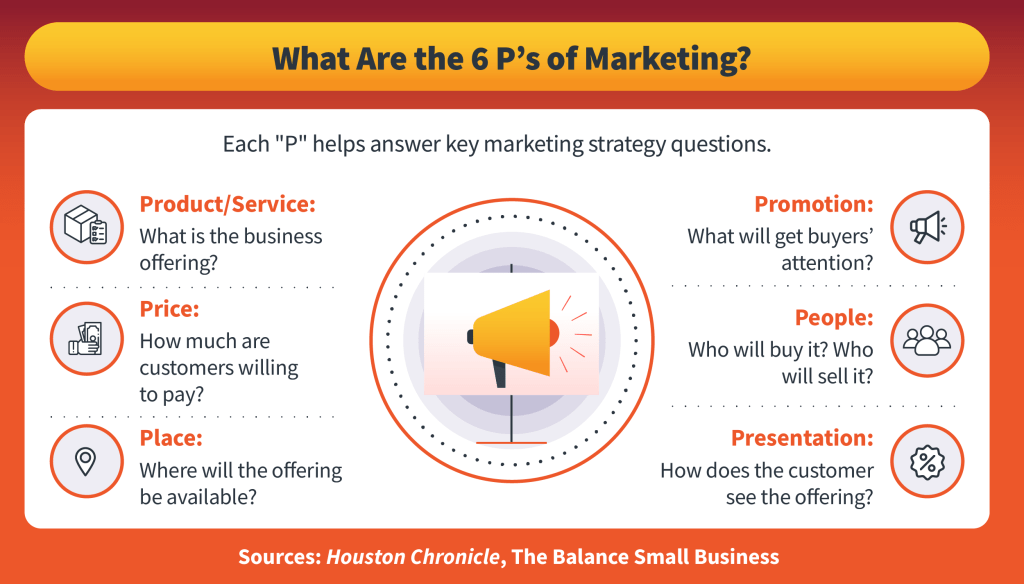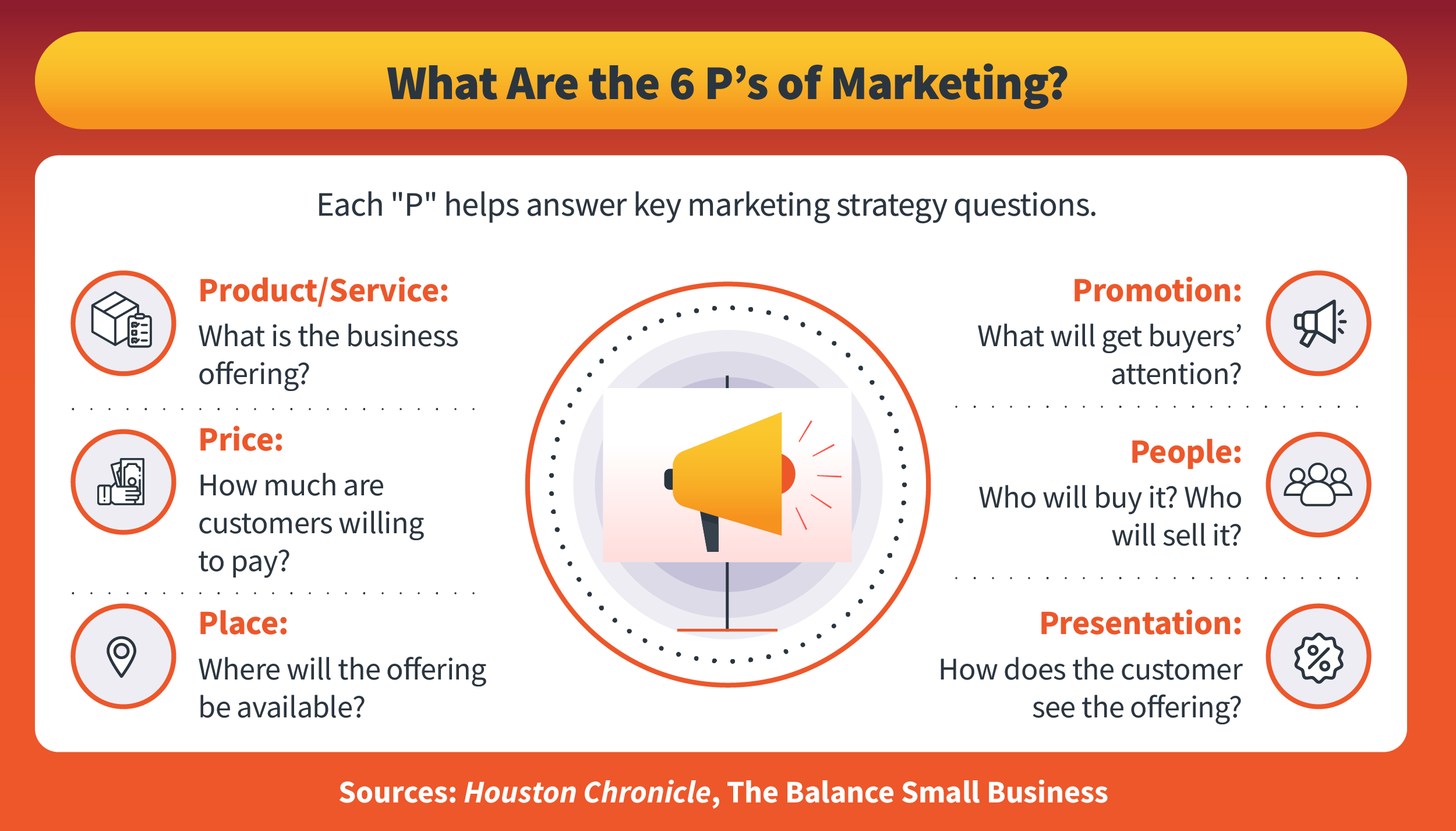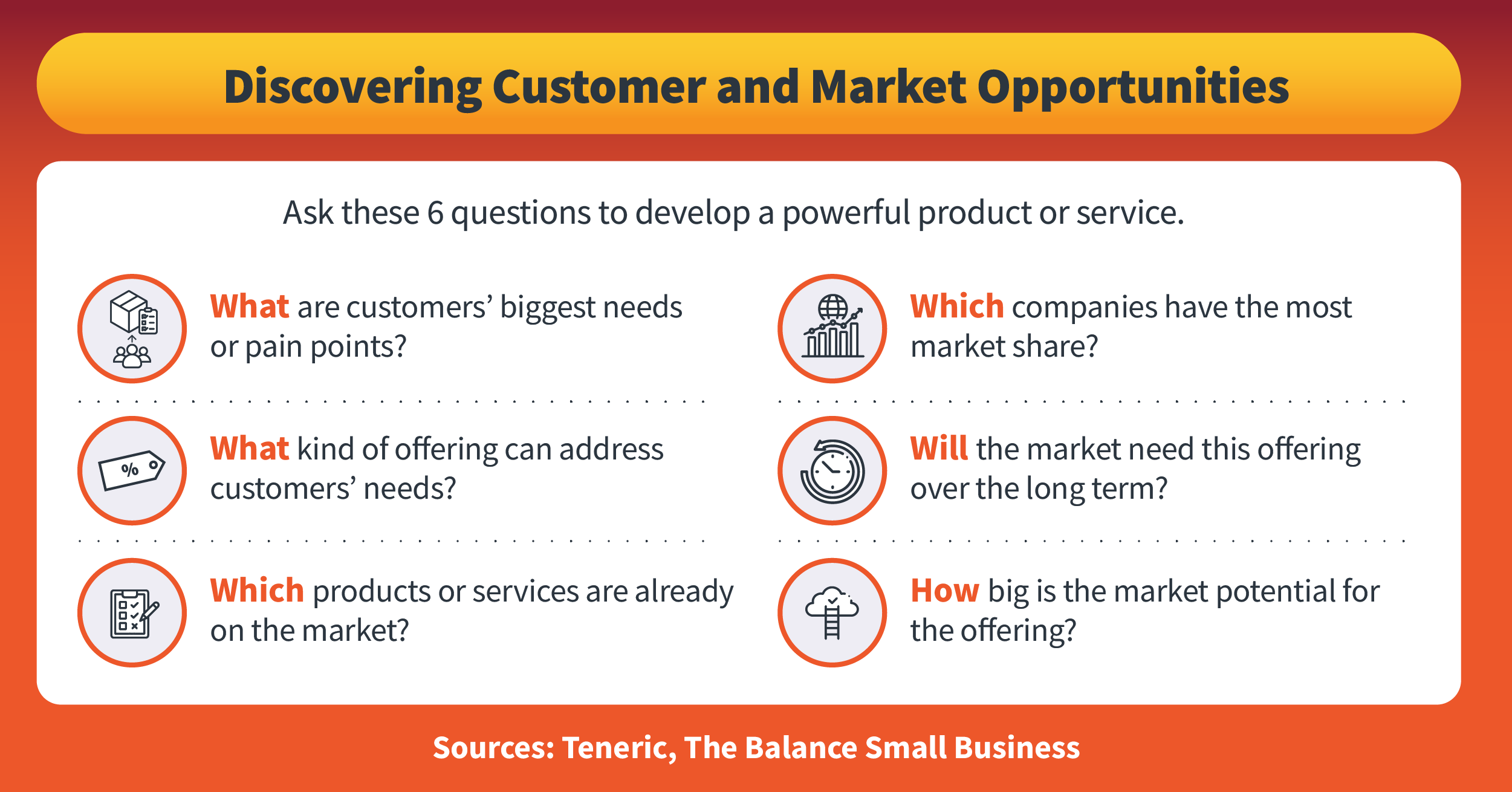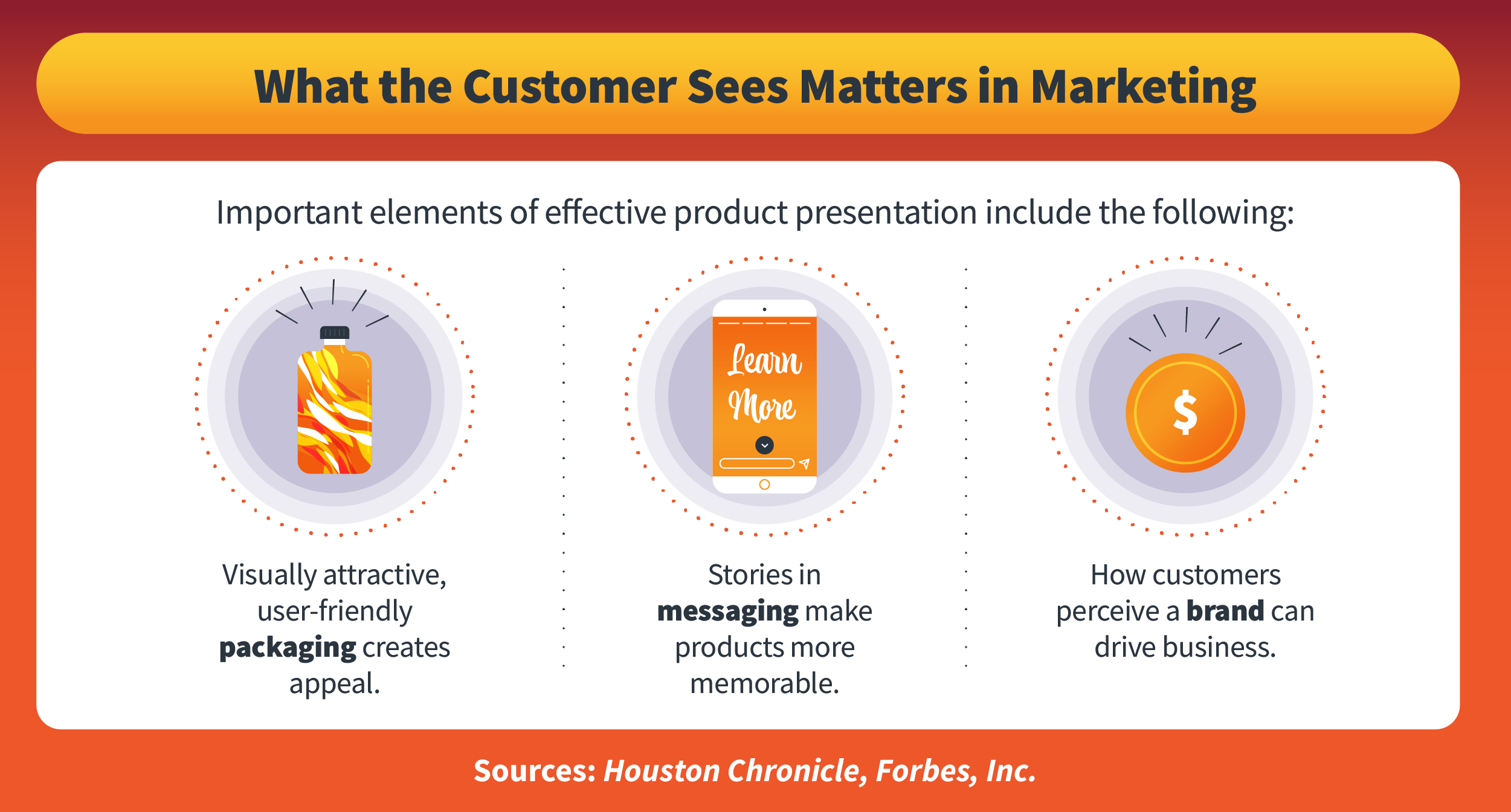6 P’s of Marketing to Grow Your Business

Tables of Contents
Companies spent about 10% of revenue on their marketing budgets in 2019, according to Deloitte’s CMO survey. Considering that most of a company’s budget is wrapped up in rigid operating expenses such as materials, manufacturing, salaries, and utilities, t for growing a business.
For any business, whether a global enterprise or small company, a comprehensive plan that outlines every possible avenue to attract customers’ attention is vital. The building blocks of an effective marketing strategy include the 6 P’s of marketing: product, price, place, promotion, people, and presentation.
The effective integration of the 6 P’s of marketing can serve as the foundation for an effective growth strategy. The 6 P’s enable businesses to achieve the following:
- Create a desirable product or service that offers value.
- Sell the product or service at a price that is attractive to customers.
- Determine the best place to sell the product or service.
- Optimize the success of attention-grabbing promotions.
- Identify the right people to improve marketing success.
- Attract customers by creating a visually appealing presentation.
What Are the 6 P’s of Marketing, and How Can They Benefit Sales?
The traditional 4 P’s of marketing — product, price, place, and promotion — have their origins as far back as the 1950s. The 4 P’s gained increasing popularity and adoption after Harvard University advertising professor Neil Borden wrote about the framework’s benefits for successful product marketing in his 1964 article “The Concept of the Marketing Mix.”
The 4 P’s of marketing have proven to be time-tested principles still relevant in the marketing mix and used by leading global companies and small businesses alike. Today, they remain a critical component of a successful marketing strategy. However, digitization has transformed the traditional marketing mix to include two additional P’s: people and presentation.
What are the 6 P’s of marketing and how does each help sales?
- Product: The product is what is being sold. Fulfilling a market opportunity with a timely product that meets customers’ needs will help boost sales.
- Price: The price is the cost the customer pays to acquire the An effective pricing strategy ensures that customers are willing to buy the product, generating sales for the company.
- Place: The place is where customers can buy the product. Whether a brick-and-mortar store, website, or app, proper placement of products creates sales opportunities.
- Promotion: The promotion includes all the tactics used to communicate a product’s value. The goal of promotion is to attract a customer’s attention and foster interest in learning more about — and eventually buying — the product.
- People: The people are the individuals involved in the marketing process on both sides of an exchange. Employees such as salespeople and customer service representatives influence how customers view a business or product, and customers provide feedback to improve the product. This interaction between internal and external people helps determine success.
- Presentation: The presentation is how the product appears in the market. Customers’ opinions of how a product is presented (for example, through packaging and messaging) can impact their buying decisions.

According to The Houston Chronicle and The Balance Small Business, each “P” helps answer key marketing strategy questions. 1. Product/Service: What is the business offering? 2. Price: How much are customers willing to pay? 3. Place: Where will the offering be available? 4. Promotion: What will get buyers’ attention? 5. People: Who will buy it? Who will sell it? 6. Presentation: How does the customer see the offering?
#1 Products and Services
Products serve as the foundation of many businesses. Those that don’t offer products often provide services. Sometimes, businesses offer both products and services, such as a car dealership that sells vehicles and provides maintenance services.
Before creating a product or service, a business should conduct research to determine its customers’ needs. A key component of its research includes determining marketplace opportunities. This may involve competitor analysis, investigating what other businesses in the field already offer, and identifying new products or services that can attract customers.
Asking questions can help businesses develop effective products and services. Here are six examples:
- What are the marketplace’s biggest needs or pain points? Products already on the market may fall short of meeting customers’ urgent needs, which are often called pain points. While developing a product or service, a company should ensure that it meets these needs.
- What kind of offering can address customers’ needs? Sometimes a business identifies a customer need that no product or service attempts to fill, offering the opportunity to develop an innovative solution.
- Which products or services are already in the market? Breaking ground in a saturated market can be difficult. After assessing existing offerings, businesses can develop a unique product.
- Which companies have the most market share? Entering a market dominated by one or two companies can be intimidating. However, identifying which companies have the most market share can determine the types of products customers are buying. This data can help a business trying to make inroads into a market to decide what product to make.
- Will the market need this offering over the long term? Is the product a consumable that needs to be regularly replaced, with built-in repeat business? If the product is a one-time purchase or has a long lifecycle, what additional services or accessories can ensure continued customer engagement?
- How big is the market potential for the offering? Some products and services can find success in serving pain points for niche audiences, while others have a broader reach. Companies may be able to establish a network of trusted customers and then scale up distribution to a larger client base.
Once the product or service is created, businesses should ask market research questions to determine its market readiness. Is it ready to be released? Do customers know the product’s purpose? Are customers primed to buy this product?
As part of a product launch plan, businesses incorporate an education strategy to inform customers of a product or service’s purpose. A key step is to develop effective descriptions that explain how a product or service brings value. Salespeople — employees or partners — responsible for generating sales must also understand the value of the company’s offerings, so product launch plans must include education strategies for them as well.
What does an effective product or service description entail? Consider these elements of successful descriptions:
- Attributes: Tells customers what the product or service is and does, and highlights specific attributes
- Uniqueness: Differentiates the product or service from competitors’ offerings
- Benefits: Explains to customers what they will gain from the product or service, which may not always be evident at first glance

Teneric and The Balance Small Business suggest asking these six questions to develop a powerful product or service: What are customers’ biggest needs or pain points? What kind of offering can address customers’ needs? Which products or services are already on the market? Which companies have the most market share? Will the market need this offering over the long term? How big is the market potential for the offering?
Resources: Products and Services in Marketing Strategy
These resources provide more information about how products and services relate to marketing strategy:
- Houston Chronicle, “Product Development Strategy Definition”: Key steps in the product development strategy lifecycle, from new innovations and product improvements to prototyping and market testing
- Marketing Insider Group, “How Marketers Can Differentiate Their Products or Service”: Six ways for businesses to distinguish their product or service in a competitive market
- The Balance Small Business, “How to Write the Business Plan Products and Services Section”: Advice for writing the products and services section of a business plan to obtain funding for new offerings
#2 Price Strategies in Marketing
Pricing makes a big difference in the success or failure of a product. Businesses must find the sweet spot between making a sufficient profit for themselves while providing financial value to customers. The most effective pricing strategies in marketing depend on several factors:
- Cost and margin: Businesses need to ensure their profit margin — the percentage of profit made for every dollar spent — is high enough to recoup costs and generate a profit.
- Competitor pricing: Markets determine the best price for a product. If a product is priced too high relative to the value it delivers, customers won’t buy it. Research competing products to determine a price that’s attractive and competitive.
- Customer behavior: Consumer-based pricing means setting prices according to customers’ perceived value of the product — and can include different prices for different customers.
7 Pricing Strategies to Grow Sales
Your pricing strategy must drive buyers to your product or service. These seven pricing strategies can maximize sales opportunities:
- Bundle pricing: This strategy involves combining several products and services, typically priced differently, into one package and charging a price that is lower than the total of the prices of the individual pieces.
- Captive pricing: This involves a core product that requires accessory products to deliver optimal value. Businesses use this strategy to generate brand loyalty and create additional sales opportunities.
- Competitive pricing: Businesses research the prices of their closest competitors and set the price of their product to match or beat the competitor’s price.
- Economy pricing: Businesses price their products and services low, which means small per-item margins, but large sales volume to remain profitable.
- Penetration pricing: Businesses use artificially low prices to entice customers away from competitors and gain market share.
- Price skimming: This short-term strategy involves setting high initial prices and then lowering them gradually over time, including offering discounts.
- Psychological pricing: The aim of psychological pricing is to use customers’ emotional responses to encourage sales. This strategy may include “buy one, get one” offers and reducing whole-dollar prices by a penny or two.
Resources: Price Strategies in Marketing Strategy
These resources provide insight into different pricing strategies and offer tips about price points as part of an overall marketing strategy:
- Houston Chronicle, “Different Types of Pricing Strategy”: Six of the various pricing strategies to sell products in competitive marketplaces
- Houston Chronicle, “List the Factors to Consider When Setting a Product Price”: Factors for setting prices, including cost and margin, the competitive marketplace, and a business’s self-discretion
- Intuit Quickbooks, “How to Choose a Pricing Strategy for Your Business”: Twelve pricing strategies for small business owners
- Investopedia, “Penetration Pricing”: The benefits and risks of setting low prices to attract new business
#3 Place in Marketing
Where a product is sold affects business success. Place refers to the site where a customer can buy a product. Consumer products such as sneakers and electronics have traditionally been sold in retail stores. Today, many retailers have gone digital. They place their products on their websites or offer them through e-commerce sites such as Amazon or Etsy. Customers’ purchases are then delivered directly to their homes.
Products should be strategically placed where customers can easily view, access, and purchase them. In physical stores, this may involve strategic product displays and merchandising. Placement in marketing also refers to product placement in large retailer displays, such as in Walmart or Target, and in television shows and commercials.
In digital stores, the user interface and search function of a site play an important role in whether a customer can find a product or not. Beyond a business’s own site, search engine optimization (SEO) plays a key role in where a product appears in the results of a search on a search engine such as Google. SEO uses keywords to attempt to strategically place products at the top of the results, where customers are more likely to find them.
Resources: Place Marketing in Marketing Strategy
Explore the following resources about place marketing in relation to marketing strategy:
- Houston Chronicle, “What Is the Difference Between Place and Promotion in the Marketing Mix?”: How place, or a product’s distribution, differs from promotion, or communication about the product
- The Marketing Mix, “Marketing Mix — Place (Distribution Strategy)”: The role of direct and reseller sales in place marketing and distribution
#4 Promotion in Marketing
Communicating a product or service’s benefits is an essential strategy for gaining marketplace attention and convincing customers to buy. One key step in promotion in marketing is to determine your target audience. After identifying an offering’s potential audience, businesses can tailor their messages to convert prospective customers into buyers, resulting in sales growth.
Traditional promotions include a vast arsenal of tactics — from flyers and magazine advertising to partnerships with other companies and public relations. Today, traditional promotions support digital promotion, which has become the primary vehicle for promotion in marketing. Gartner’s CMO spend survey reports that about 80% of marketing budgets were spent on digital channels in 2020.
Traditional and digital promotions can work together to maximize a marketing campaign’s success. Below are a mix of traditional and digital marketing strategies that can help businesses reach customers and generate sales:
- Email marketing: One of the first digital promotional tools, sending emails directly to prospects and customers remains a highly effective strategy. Email marketing campaigns aim to convert prospects into customers and build brand loyalty.
- Public relations: The aim of public relations is to spread favorable information about a business and its products to people and organizations who can influence potential customers — for example, newspapers with a large subscription base, or social media influencers with many followers. The goal is to impact public perception, garner attention, and generate interest.
- Advertising: This traditional promotional tactic involves paying for the opportunity to market a product or service to a media outlet’s viewership or subscriber base. Today, digital advertising comes in many forms, from interactive videos to in-app sponsorships.
- Content marketing: The primary aim of content marketing is to create content of relevance and interest that target audiences share organically, spreading marketing messages without paid advertising. When memes, videos, and social media posts spread virally, they generate interest in a product or business without the costs of traditional advertising.
- Social media: Any digital tool that allows users to quickly create and share content is considered social media. A tactic in social media marketing is to leverage influencers to share messaging about a product or service to their followers. Some major social media platforms include Facebook, Instagram, Twitter, and YouTube.
- Contests: Contests such as sweepstakes and giveaways capture leads, who provide their information for a chance at a prize. Although a longstanding traditional promotional method, contests have also become popular in digital marketing.
- Customer referral incentive programs: This strategy relies on the power of word-of-mouth marketing, offering discounts or promotions to existing customers who recommend a product to their colleagues, friends, or family members. Referrals can be effective, as prospects are often more likely to consider buying a product if someone they trust recommends it.
- Point-of-sale (POS) promotions: Traditionally, point-of-sale displays are placed near checkout counters to draw customers’ attention to products they did not enter the store to buy. This strategy is highly effective for seasonal or holiday-time sales. Digital customers can also receive point-of-sale promotions in their digital checkout carts.
- Customer appreciation events: This tactic gives businesses an opportunity to show that they appreciate their customers by offering them gifts, incentives, or special deals. The primary aim is to strengthen customer loyalty.
- Surveys: Surveys allow businesses to capture the opinions of their customers and improve their products and services to meet their needs.
Resources: Promotion in Marketing Strategy
What promotion in marketing strategies can help businesses succeed? The following resources provide strategies and tips:
- Houston Chronicle, “Top Ten Promotional Strategies”: Various traditional promotion in marketing strategies
- Evinex, “Promotion Strategy: How to Promote Your Business [2021]”: Ways to improve your marketing plan, from strategy fundamentals to marketing metrics
#5 People in Marketing
The fifth P in the marketing mix is people. Businesses regularly deal with people outside their organization such as customers and partners. Individuals working in marketing are focused on attracting external audiences to generate revenues for their company.
A company’s internal people — production workers, managers, customer service representatives, salespeople, and support staff — are vital to the success of the marketing mix. These individuals set the tone for a company culture that either attracts or repels business. First impressions about a business count, and everyone involved in a product or service, from customer-facing employees to those working in production, distribution, and delivery, have both a direct and indirect impact on sales and customer satisfaction.
People strategies involve recruiting and hiring individuals who can contribute to a business’s success. To find the right candidates, businesses use marketing strategies — selling the company itself — to attract top talent. Hiring effective staff can optimize the impact of marketing strategy and activities, and bolster a business’s reputation.
Resources: People in Marketing Strategy
These resources discuss the different roles of people in marketing:
- The Marketing Mix, “The Importance of People Within the Marketing Mix”: A deep dive into the fifth P of marketing
- CSEK Creative, “The 3 P’s of Service Marketing”: The “forgotten P’s” of service marketing and how they focus on the role of people

Important elements of effective product presentation include the following from The Houston Chronicle, Forbes, and Inc.: Visually attractive, user-friendly packaging creates appeal; stories in messaging make products more memorable; how customers perceive a brand can drive business.
#6 Presentation
Even when a product or service is superior to the competition, selling it depends on effective presentation. This sixth P of marketing focuses on the product’s appearance and whether it accurately represents the business’s image. Designers, creatives, and other professionals involved in presenting products should identify the type of customers the business wants to attract, and tailor a presentation to appeal to that target audience.
Important elements of presentation include:
- Packaging: The package determines the product’s impression at first glance. On retail store shelves, a product is competing with hundreds of others. Effective packaging can help your product stand out to consumers.
- Messaging: Messaging focuses on what a company wants to communicate to customers about the company, brand, and product or service. Messaging highlights a product’s primary selling points, but it can also express company values.
- Branding: What effect does your brand have on consumers? What thoughts and feelings are associated with your brand? Positive perception of a brand can drive business.
Resources: Presenting Product in Marketing Strategy
Presentation of a product or service matters. The following resources offer perspective on the role of presenting products in relation to marketing strategy:
- Forbes, “The Importance of Branding in Business”: The key role presentation and branding play in how people perceive a business by building trust and creating loyal customers
- SAP Community, “The Importance of Presentation in Product Marketing”: The value of presentation in improving image and sales
Different versions of the marketing mix model may incorporate other P’s, such as process and positioning. Process describes the start-to-finish effort involved in building and marketing a product, from conception and production to sales and final delivery. Positioning describes how a customer understands the product, its brand, and its benefits.
Tailoring the 6 P’s in Marketing Strategy for Your Business
A lot has changed since the introduction of the original 4 P’s of marketing. Digital innovation keeps changing how products are developed, presented, sold, and delivered. No cookie-cutter marketing strategy fits the needs of every business: Each company has to assess its brand’s and products’ value and identify the best strategies, tactics, and vehicles to garner customers’ attention. This requires understanding the needs of the market.
When creating a marketing strategy, businesses should first understand all elements of the 6 P’s of marketing. With this knowledge, they can develop effective marketing strategies tailored to the unique needs of their business that highlight the benefits of their products or services to customers.
Infographic Sources
The Balance Small Business, “10 Questions You Need to Answer to Create a Powerful Marketing Plan”
The Balance Small Business, “What Are the Elements of a Marketing Mix?”
Forbes, “3 Reasons Why Brand Storytelling Is the Future of Marketing”
Houston Chronicle, “How Does Packaging Affect Consumers?”
Houston Chronicle, “What Major Elements Comprise a Good Marketing Strategy?”
Inc., “How to Increase Sales by Building Brand Equity and Shaping Brand Perception”

